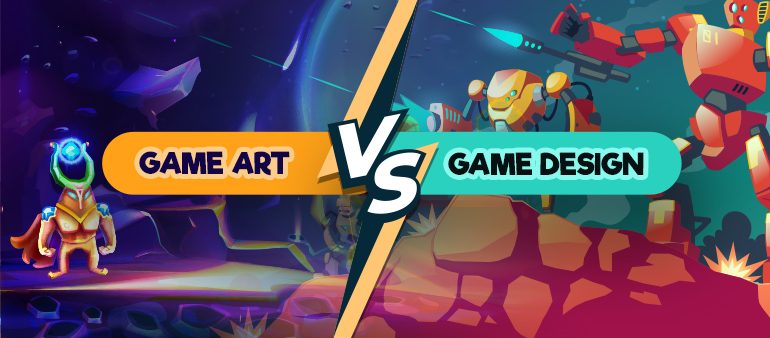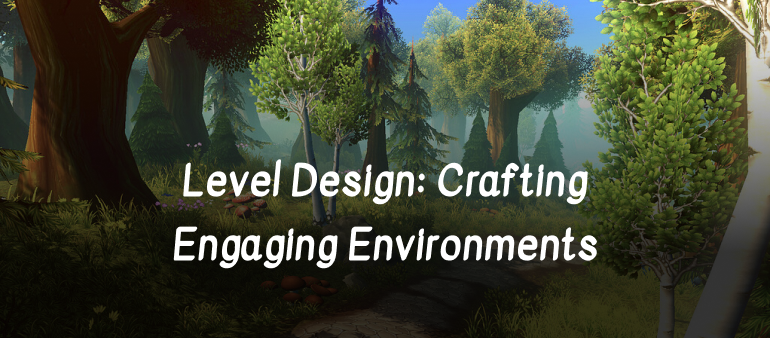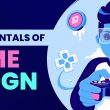Video game development is a collaborative process that involves various people with specialized skills. The two most critical roles in this process are game artists and designers. Though both roles are essential, they have distinct responsibilities and roles.
Since most of us are unaware of the process of creating a game, we usually confuse game design and game art as being the same. Understanding the difference between the two is vital if you are an aspiring game developer, a passionate gamer, or you are considering hiring a game development company to develop an immersive video game. In this blog, we will discuss the difference between game art vs game design and how each plays a unique role in game development.
Who is a Game Artist?
The game artist develops the visual components of the game, which involve the characters, props, background, environment, and other visual elements. They bring life to the game by developing 2D and 3D models of game elements using tools like Unity, 3Ds Max, and more. They work closely with game designers as well as developers to build a well-designed and visually attractive game. Video game artists specialize in a wide range of digital art forms, such as 2D modeling, animation, concept art and texturing.
Let’s take the popular example of Candy Crush Saga, a level-based puzzle game. It had art elements like beautiful and vibrant backgrounds, shiny candy pieces, and little creatures that made it more fun for gamers.
The Role of Game Artists
Concept artist
The game concept artist creates the initial visual concepts of the game (characters, environments, props, vehicles and other visual elements) in accordance with GDD. They set the style and mood of the work, giving life to an abstract idea.
Character artist
The character artist shapes the characters through the creation of visual elements like facial expressions, weapons, and clothing through the use of sculpture, rigging and editing. They collaborate with creative and technical teams to enhance the game’s visual appearance and maintain a uniform character design.
Visual effects (VFX) artist
By incorporating visual elements and effects into the game, VFX enhances the player’s gaming experience. They create animations for things that are neither objects nor characters. Fire, water, and smoke are some examples of visual effects you may have seen in games. It is mainly used in combat and RPG games and can be divided into environment effects (lightning) and gameplay effects (gun, fire).
Environment artist
An environment artist creates a fantasy game world by adding buildings, landscapes, colorful backgrounds and props that match the game design. Their primary responsibility is to develop realistic and aesthetically pleasing environments for gamers to explore. They work with level designers, game designers, and art directors to ensure the atmosphere complements the game’s overall vision and gameplay.
UI/UX artist
A UI/UX artist creates the visual aspects of a game’s user interface, menus, icons and other interactive components. They must develop a user-friendly and visually appealing interface so players can navigate the interface with ease.
Who is a Game Designer?
A game designer designs the overall concept of a game. They conceptualize game plots, storylines, character interactions, levels and environments, and other creative aspects. They are involved in every stage of game development, from basic ideas and designs to testing and release. Game designers must work closely with other development team members, like developers and artists, to guarantee that the video game mechanics and elements work together smoothly. Technical factors like compatibility, system requirements and performance optimization are also considered.
Let’s take the example of Candy Crush again. The game mechanics involve matching three or more candies of the same color to smash them. The game starts with simple gameplay, but the difficulty increases as you move up the levels. Similarly, the powerups in the game are designed to entice and motivate gamers to continue playing.
The Roles of a Game Designer
Creative
Being creative is one of the primary roles of a game designer. They come up with ways to present the game plot, work out the script and plan the game levels. Game designers must ensure that the artists comprehend the style and mood of the game correctly and provide appropriate visual content. Also, they must be creative and design innovative gameplay features that will set their games apart from the competition.
Technical
In addition to being creative, a game designer must also be technically proficient. They must be familiar with game engine capabilities and the technical limitations of the assigned platforms. They must possess a comprehensive knowledge of prototyping, testing, programming, and development techniques to craft a seamless gaming experience. Moreover, they should also be familiar with UI design and utilizing software to create a visually attractive and intuitive game.
What is the difference between game art vs game design?
Although game art and design are entirely different, they are inextricably linked. The former is responsible for creating high-quality game artwork, like characters, environments, textures, animation, 2D/3D models and UI design. Game designers work on concepts, systems, player progression, balancing and level design.
Game art and game design play an integral role in developing immersive and captivating experiences, yet these two require various skill levels and expertise. Video game artists must be highly creative, technically skilled and artistic in painting, drawing, animation, 3D, and modeling. On the other hand, game designers must possess strong analytical skills and the ability to solve complex problems. They should also strongly understand game mechanics, user experience and psychology.
By now, you would have understood the difference between game art vs game design. And you may also have a basic idea of the various roles of game art and design.
To sum it up, while game art vs game design plays an essential role in the game development process, they work differently from beginning to end. Even though they are distinct from one another, they are both vital processes in game creation that go hand in hand with one another. The designers at Logic Simplified are expert professionals with experience in designing and developing games for different genres. Our team of professional game designers and developers work together to build visually appealing and captivating games. To know more about us, contact us or drop us an email at enquiry@logicsimplified.com.
 Get a Quote
Get a Quote













